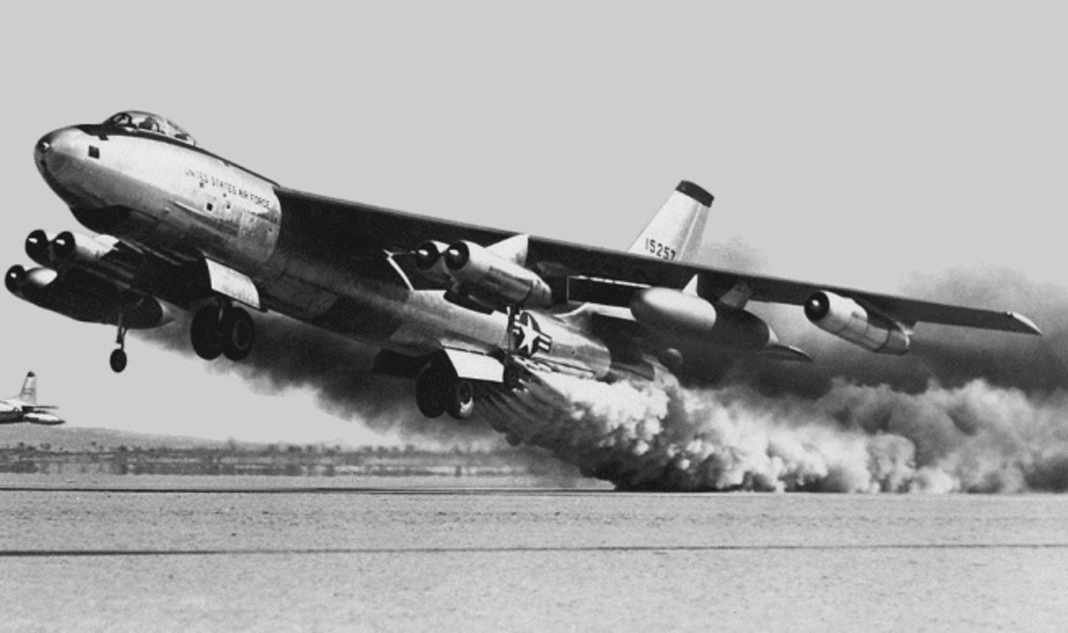[ad_1]
Six General Electric J35 turbojets and Jet-Assisted Take Off (JATO) rockets powered the Boeing B-47 Stratojet.
Boeing designed the B-47 as a long-range strategic bomber capable of flying at high subsonic speeds fast enough to avoid enemy interceptors.
The first Stratojet flew in 1947 as the United States and the Soviet Union began deploying nuclear-capable aircraft in the early days of the Cold War.

Poor Acceleration of Turbojets Led to Need for Jet-Assisted Take Off on B-47
In 1947, early turbojet models lacked the acceleration of piston engines, which required manufacturers to add supplemental propulsion to some aircraft. Recognizing this need for more power, Boeing decided to add 18 solid-propellant rockets to the XB-47 prototype. They installed nine rockets in rows of three inside the fuselage on each side behind the wings.
The initial prototype XB-47s had six General Electric J35 turbojets, each producing 3,750 pounds of thrust, for a total of 22,500. When engineers found the engines did not provide enough trust at low speeds, they added the JATO system. Each rocket produced 1000 pounds of thrust, adding 18,000 to the total from the turbojets.

In the following years, updated versions of the B-47 turbojets gave it considerably more power. On the B-47B, J47-GE-23 engines provided 5,800 pounds of thrust each. These improvements continued to the B-47E model, which had J47-GE-25A engines with 5,970 pounds of thrust.
Turbojet Improvements Reduced Need for Rockets on Takeoffs
Although Boeing continued to install the Jet-Assisted Take Off rockets up through the B-47E model in 1953, the more powerful turbojets reduced the need for the rockets. Also, the J47-GE-25A engines featured a water and methanol injection system, which improved their thrust. Injecting a water and methanol mix into the engines during takeoff increased the mass flowing through, boosting the thrust to 7200 pounds.
Eventually, engineers became concerned that the JATO rockets were too close to the B-47’s fuel tanks. The bomber held all its fuel in the fuselage instead of the wings, which flexed a great deal during flight and were thin, making them unsuitable for carrying fuel.
Engineers then modified the B-47Es by removing the standard JATO system and replacing it with an external setup. This setup was a “horse collar” rack that could be mounted under the rear of the fuselage. It held 33 JATO rockets in three rows of 11. The entire rack was jettisonable and basically throwaway. Crews using it could drop it after takeoff.

Following this, Boeing still used JATO, but only for emergency alerts when aircraft had to get airborne as fast as possible. Beyond that, units still trained on JATO systems, but only about once per year.
Soviets the First to Test JATO
The first use of JATO on aircraft came in 1931 on the Soviet U-1 training aircraft. A biplane, it had just a 120-horsepower rotary engine and a maximum speed of about 84 miles per hour. Engineers V.I. Dudakov and V.A. Konstantinov experimented with rocket boosters during takeoffs. When the rockets fired, the U-1’s takeoff run was 1.5 seconds. The Soviets tested this system on one hundred takeoffs.

The United States first tested rockets in WWI. Robert Goddard received a contract to develop solid-fuel rocket weapons.
U.S. Asks Scientists to Study Effectiveness of Rockets on Aircraft
In 1939, the U.S. considered using JATO on aircraft. A team of scientists received $1000 from the National Academy of Sciences to research rocket-assisted takeoff technologies. On one test, they installed several solid-fuel 28-pound boost rockets on a piston-engine Ercoupe plane. Each rocket produced thrust for about 12 seconds.
After several successful test runs, they removed the plane’s propeller and installed six JATO units under the wings. The pilot, Army Captain Homer Boushey, took off in what was the first flight by an American pilot in an aircraft with only rocket power.

Blue Angels C-130 No Longer Using Jet-Assisted Takeoffs
After the B-47, the United States used JATO systems on various aircraft, including the OV-10 Bronco and C-130 Hercules. The Navy’s Blue Angels demonstration team used to travel with a C-130 nicknamed “Fat Albert.” It had eight Jet Assisted Take Off rocket bottles mounted behind its wings. It used up the last remaining JATO bottles in 2009, and they were not replaced. The Navy has since transitioned to a C-130J Super Hercules. It has enough thrust that is does not require a JATO system.

[ad_2]
Source link


